|
Gattorna Says:
|
 The
truth is that most organizations
have not reached an acceptable
level of understanding
of their customers’
dominant buying behaviors,
because they haven’t
really been thinking in
these terms...
The
truth is that most organizations
have not reached an acceptable
level of understanding
of their customers’
dominant buying behaviors,
because they haven’t
really been thinking in
these terms...
What
do you say? Send
us your comments here
|
Let’s
cut to the chase and stop dancing
around the issues that pervade
contemporary supply chains.
People, and people alone, are
at the centre of every enterprise
supply chain that exists in
the world today. On the outside,
we call these people ‘customers’
or ‘clients’ (or
indeed ‘credit risks’
at times), and on the inside,
we have Boards, management,
and employees. That’s
a lot of involved people! But
where are the HRM professionals?
Aren’t they supposed to
advise and assist top management
to shape all this ‘people
power’ on the inside of
organizations so that we can
better satisfy customers and
produce a correspondingly improved
bottom line? Of course there
is no ‘bottom line’
if there is no ‘top line’,
a fact that is sometimes lost
on managers with a 1-Dimensional
focus on costs only. It seems
to me as I travel the world
and engage with major corporations,
that the number of HRM professionals
is increasing, but what are
they all doing? I see no evidence
that they have mastered the
complexity that disparate human
behavior brings to organizations,
and by extension, supply chains.
Quite to the contrary, I observe
a reversion to type, where they
pre-occupy themselves with routine
activities that they feel comfortable
with, e.g., personnel administration,
car policies, recruitment, wages
and award payments, health and
safety, superannuation, and
other routine matters.
A
more enlightened view of contemporary
supply chains
Supply
chains permeate every type of
enterprise, whether commercial
or not-for-profit. They are
the ‘pathways’ through
which products and services
move as they gather value (and
cost) en-route to the end user/consumer.
Along the way there are lots
of processes, activities, and
relationships involved, enabled
by technology and infrastructure.
But the latter are only enablers,
not the main game. I think we
have forgotten this reality
as we have progressively become
smitten by advancing technology,
and in turn this has side-tracked
many an organization from the
correct focus - customers. This
reality is particularly true
of enterprises that have been
through the rigors of implementing
an ERP system. But it should
not necessarily be the case.
The
truth is that most organizations
have not reached an acceptable
level of understanding of their
customers’ dominant buying
behaviors, because they haven’t
really been thinking in these
terms, although few if any will
admit it. I see very few enterprises
in my travels which genuinely
understand and have an in-depth
knowledge of their customers.
Even those that do appear to
quarantine that knowledge in
functional silos such as Marketing
or Sales, which leaves the back-of-shop
operators largely in the dark
and second guessing customer
requirements. Hey, if we would
only admit to ourselves that
the real enemy is on the outside
of the organization, not on
the inside, we would be much
better off! The real villains
here are Marketing and Sales
personnel who are not doing
enough to translate their sometimes
intricate knowledge through
to other parts of the enterprise.
But we will leave that particular
argument for another day.
Aligning
the enterprise around customers
There
is only one fail-safe frame-of-reference
when designing and operating
contemporary supply chains;
the customer and the customer
situation. This is the starting
point for all subsequent action.
If you don’t think this
way, you are guessing! Once
you fully understand the behavioral
structure of your marketplace,
it is possible to ‘reverse
engineer’ the configuration
of your supply chains back through
the organization to actual operations
on the ground. And, because
there is always more than one
type of customer dominant buying
behavior evident in any product/service
market category, it follows
that there is likely to be more
than one type of supply chain.
Indeed, I have consistently
found empirical evidence to
suggest 3-4 generic types of
supply chain, and/or variations
of these, in different mixes
depending on the product, service
or country. Briefly, these are
as follows:
- Continuous
Replenishment supply chain
to service the ‘Collaborative’
segment;
- Lean
supply chain to service
the ‘Efficiency’
segment;
- Agile
supply chain to service the
‘Demanding’ segment;
and
- Fully
Flexible supply chain
to service the ‘Innovative
Solutions Seeking’ segment.
And
as customers move away from
there natural or preferred buying
behavior, there is a good chance
that they will move, either
temporarily or permanently,
to one of the other three buying
states listed above. In some
large organizations it is possible
to discern more that one buying
behavior present. So, any response
must have a dynamic capability;
not this duck-shooting where
you have a single response,
and endeavor to infinitely adapt
this response as customers move
across your sights. That approach
is cost prohibitive because
of the myriad of exceptions
involved, and it is very wearing
on the people inside the business.
Once
you pin down the structure of
your marketplace, it is possible
to develop a corresponding range
of responses that align with
the different customer’
buying behaviors you have identified.
This is simply a packaging
exercise where you mix and
match such attributes as price,
branding, speed and/or consistency
of delivery, relationships,
degree of innovation, and more.
The same basic product or service
can be delivered in many different
ways to suit the same or different
customer. All well and good,
but the problems are only just
starting. The devil is in the
implementation of the supply
chain configurations to deliver
these intended strategies,
rather than their formulation,
and that is where people play
the major roles, front and centre.
They can either make things
happen, or resist simply because
they want to. This is an insidious
form of resistance because it
is difficult to measure in real-time,
and often the effects only become
apparent after significant time
has elapsed. And by then it
may be too late to recover.
The
key to successful execution
is people
The
‘dynamic alignment’
concept requires that four levels
of human endeavor be aligned:
marketplace; response(s)
to customers; internal cultural
capability; and leadership
style, all held together
primarily with leadership, organization
structures, processes and technology.
The biggest problems occur at
the interface between intended
responses (strategies) and internal
cultural capability of the enterprise.
Indeed, 40-60 percent of written
plans are never delivered on
the ground, and the reason for
this is the dislocation that
occurs at the strategy-cultural
capability interface. It is
not due to competitor activity
as many would have us believe.
The root cause of non-performance
is much closer to home, i.e.,
inside the enterprise itself,
a type of ‘Trojan Horse.'
My question, therefore, is as
follows: what have HRM professionals
been doing to understand and
address these issues? Where
is the research to better inform
practice? In short, where have
they been when we needed them
most? Are they not the custodians
of the corporate culture. How
have they advised top management
in the quest to reduce obvious
‘mis-alignments,' particularly
at this crucial interface? The
answers to all these questions
are pretty negative, and worst
of all, there is little or no
respite in sight. Organizations
continue to operate much as
they have for decades, and educational
institutions are teaching the
same old stuff to their students,
the next generation of managers.
It’s a vicious circle
that we must break out of sooner
rather than later. That time
is getting closer for many organizations,
otherwise they won’t survive.
The
four generic supply chain alignment
configurations
Each
of the four (4) generic supply
chain types listed above look
different at each level of the
alignment framework. They have
to be in order to focus on a
particular dominant buying behavior.
Each of these unique configurations
are described in the following
schematics.
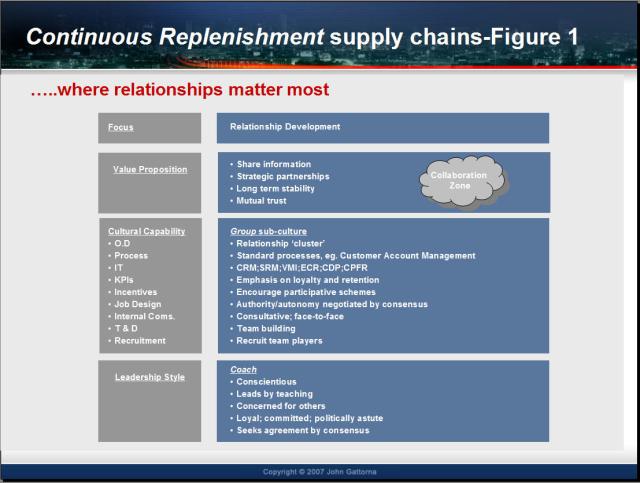
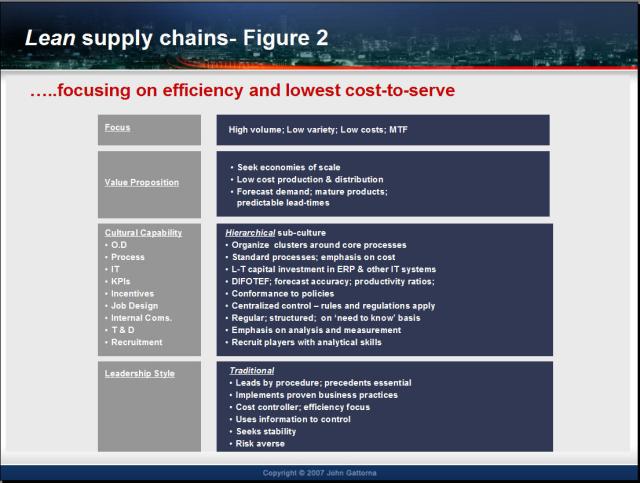
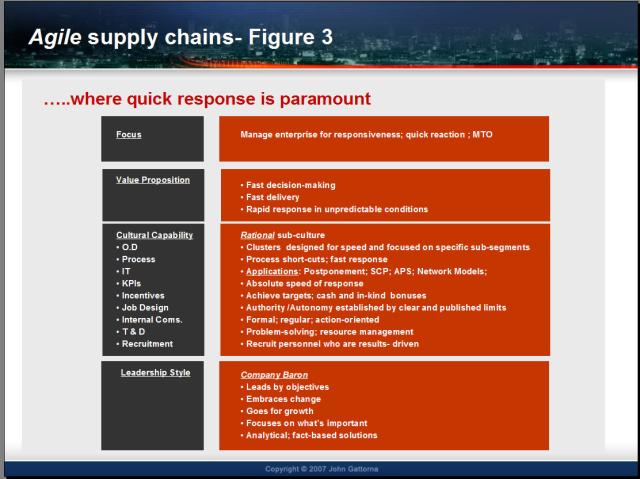
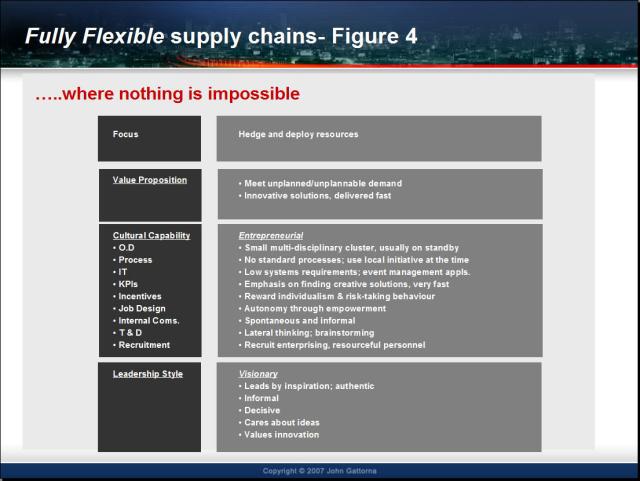
For
purposes of this discussion,
we will focus on the forces
at work at the cultural capability
level, because it is here that
the human action inside the
enterprise plays out, mostly
hidden from view. This is also
where the forces of darkness
lurk, leading to gross organizational
ineffectiveness. It is also
right here that we need HRM
professionals to be focusing
their attention, and providing
technical advice and support
to senior management. The following
attributes that shape and create
sub-cultures are the ones we
want them to focus their attention
and energies on.
- Organization
design: other than ‘leadership
style’ itself, this
is the most powerful force
for shaping sub-cultures because
it constrains the way people
work, like a straight jacket.
Unfortunately, it is also
the area that has seen the
least progress over the last
several decades. Organizational
designers have been unable
(or unwilling) to come up
with anything better than
the traditional functional
silos, and a variation of
this, the matrix structure.
Functional silos served us
well in the relatively slow-moving
world of the 1950s, 60s, and
70s, but have become progressively
more mis-aligned with the
way customers want to buy
over the last two decades.
It seems we will never rid
ourselves of this format,
and maybe we won’t have
to. More about that point
shortly.
Matrix
organization structures were
introduced to overcome the
weakness highlighted above
in functional silos, but has
generally not been effective,
and will not get any more
effective from here on. The
problem is the internal conflicts
generated at each intersection
between an Account Manager
and the all-powerful vertical
functions that hold the budgets.
No joy there.
In
my view, there is a way forward
that allows us to engage and
align with customers more
effectively in a fast-moving
operating environment. I called
this organizational format
a ‘cluster.' The idea
is to build groups or clusters
of multi-disciplinary personnel
that faithfully replicate
both the competences required
to service a particular customer
segment, as well as embedding
the required mindset bias.
For example, where we have
a Continuous Replenishment
supply chain aligned with
a Collaborative segment
of customers, it is important
to embed a ‘relationship’
mindset or sub-culture, and
support this with the appropriate
processes and technology as
discussed below.
In
this way we can keep the conventional
functional silos in place,
but with a different raison
d’etre. They become
the repository of specialist
skills and competences, and
the ‘force generator’
from which the new clusters
draw personnel of all disciplines
for short or long-term assignment
to particular clusters. It
would look something like
that depicted in Figure 5
below.
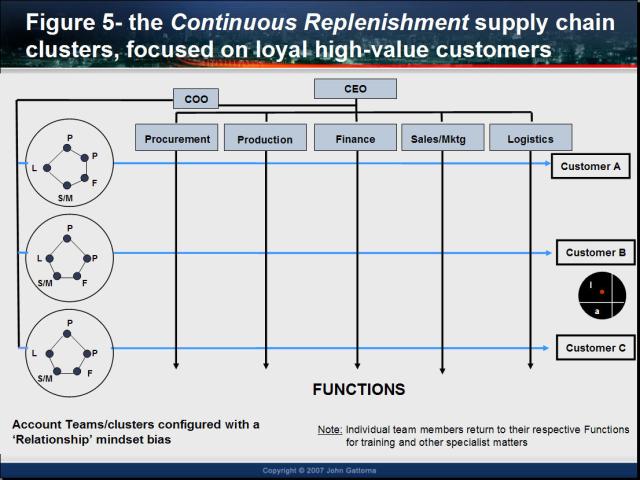
Likewise,
clusters for each of the other
three types of supply chain
can be configured with the appropriate
mix of disciplines and mindsets.
Surely this is an area where
HRM professionals can play a
major role, working with functional
and cluster heads to engineer
the required configurations.
It is here that the second attribute
comes into play.
- Positioning
square ‘pegs’
in square holes: this
is where The fine tuning occurs.
Personnel are closely reviewed
in terms of their technical
skills and mindsets, using
such techniques as the MBTI
for the latter, to ensure
they ‘fit’ any
roles they are appointed to.
We are talking about nuances
here, but they count tremendously
towards organizational effectiveness
at the aggregate level. The
days of wiping out whole layers
of management are gone. Looking
back, that was borne of ignorance.
- Process
re-engineering: there
are no mysteries here, but
the key is to ensure that
the primary processes that
align with each supply chain
or pathway are in place. They
become standard and are invoked
by the cluster as required.
- Information
technology and systems:
these simply mimic and institutionalize
the processes already established.
The problem to date has been
that organizations have been
throwing the full gambit of
systems technology at every
type of customer situation,
without discrimination, looking
in vain for the ‘Silver
Bullet.' There is no such
thing in supply chain management.
What we need is an underpinning
ERP system to provide one
version of the truth, and
then interface this with different
mixes of IT applications as
appropriate. So for example,
the main application servicing
the Collaborative customer
segment might be a CRM system.
It will help us manage the
loyal high-value customers
in the way they expect, where
relationships and trust are
paramount.
- KPIs:
this is an area of management
that seriously impacts on
performance, but is as yet,
badly understood. People will
do what is inspected, not
what is expected. So you have
to use this principle in framing
the KPIs unique to each type
of supply chain. Out with
the so called ‘Balanced
Score Card,' and in with the
‘Biased Score Card,’
which is purposefully designed
to faithfully signal what
you want our people to do.
In the case of servicing customers
in the Collaborative
segment, this might mean focusing
on a few vital KPIs such as:
length of time we have retained
the customer (Customer Retention);
and share of customer’s
spend in a particular category
that we have (Customer Loyalty).
- Incentives:
these are the mirror image
of the KPIs, selected for
particular situations. It’s
a matter of ‘horses
for courses.' What are the
most appropriate incentives
for personnel who are themselves
steeped in relationship building
and maintenance. Is it cash?
Or is it something else in
kind. Again, over to the HRM
professionals to figure this
out. That’s what they
are paid to do!
- Internal
communications; different
sub-cultures have different
communication styles. The
trick is to embed the style
that aligns with the sub-culture
you are trying to shape. In
the case of the organizational
cluster driving the Continuous
Replenishment supply chain,
this is likely to be very
inclusive, with actions only
being taken after a consensus
is reached. To be fair, this
can sometimes be a slow process,
but then again, when you are
servicing this type of relationship-focused
customer, time is on your
side. Nothing changes fast.
Everything is a result of
a lot of thoughtful consideration.
So the cluster is just reflecting
this trait.
- Training
and Development: here
we expect that HRM professionals
will design and conduct a
personal development program
(PDP) for each and every individual
executive. Gone are the days
of spending big on mass training
initiatives. This was wasteful
at best, and a dereliction
of duty at worst.
- Recruitment:
this final parameter represents
a very powerful force for
‘genetically engineering’
selected sub-cultures in an
organization, to reflect the
external market structure.
Thankfully, I have met a number
of recruitment firms recently
that get it, and are actively
engaged in delivering individuals
to enterprises that meet technical,
experiential, and mindset
parameters. Logistics
Recruitment (a Sydney-based
global recruitment network,
with offices in 10 countries
that recently launched the
world’s first global
careers site for supply chain
and logistics professionals
(www.SupplyChainJobz.com))
is one such organization,
and their efforts are to be
applauded. What we need from
the internal HRM professionals
is engagement in this vital
enterprise-building process.
Finally,
there is the over-arching influence
of Leadership styles, that are
perhaps as important in shaping
sub-cultures in organizations
as organization design. Here
again, there are plenty of sophisticated
tools available to HRM professionals
to measure and monitor management
and leadership styles, but you
also have to know what to do
with this data.
HRM
professionals can assist management
by helping and advising in the
formation of the various clusters,
and in particular which individual
executive is appropriate for
the particular leadership role
being considered.
Final
word: some evidence to reflect
on
At
the Smart’07 Conference
in Sydney in June 2007, I addressed
an audience of some 300 people
on the topic of my book, Living
Supply Chains, and what
this meant for designing and
operating contemporary high-performance
supply chains. At the end of
my address, I asked this audience
six (6) questions. The results
are below, and if this audience
is typical and representative,
which I think it is, we
have a long way to go indeed.
Wake up HRM professionals and
get on the job! Your managements
need help.
Q1:
Has your company/enterprise
attempted to design/operate
its supply chain network along
‘alignment’ principles?
Yes: 33%; No 67%
Q2:
Has your company/enterprise
used behavioral segmentation
of customers to inform the
design/operation of it’s
supply chains? Yes
21%; No 79%
Q3:
Has your company consciously
attempted to shape various
sub-cultures to execute the
different types of supply
chains (pathways) that are
running through the business?
Yes: 32%; No 68%
Q4:
Does top management in your
company treat logistics/supply
chain management as a specialist
‘function,' or as an
integral part of the business?
Yes: 69%; No 31%
Q5:
Do you think top management
in your company understands
the role culture plays in
powering corporate supply
chains? Yes 38%; No 62%
Q6:
If no, are they in denial?
Yes 77%; No 23%
Perhaps
you might like to answer the
same questions yourself to get
a reading on how far you are
on or off the pace.
Agree or disgree
with our expert's perspective?
What would you add? Let us know
your thoughts for publication
in the SCDigest newsletter Feedback
section, and on the web site.
Upon request, comments will
be posted with the respondents
name or company withheld. |